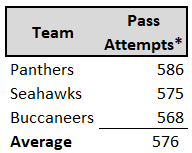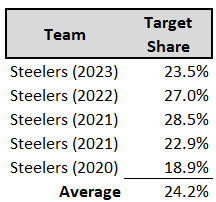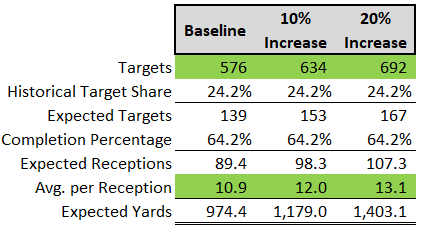Dynasty GAAP Memo: Diontae Johnson

If you have read my work before, you know I write in the form of “accounting memos” and apply accounting and finance themes to dynasty fantasy football. For anyone who has not been exposed, the format is very standard. Each memo will start with the “purpose.” Next, it will supply background and then outline the applicable “guidance,” or accounting literature utilized. Last will be the analysis and conclusion. The goal is to state the issue and quickly address it. My write-ups will follow this same logic. To summarize, welcome to “Good at Analyzing Players” or “GAAP”, a play on “Generally Accepted Accounting Principles” (and yes, my wife did come up with it).
Purpose:
The purpose of this memo is to evaluate the dynasty value of Carolina Panthers wide receiver Diontae Johnson and evaluate his opportunity during the 2024 season.
Background:
Johnson is 27.4 years old and heading into his sixth season after being selected in the third round of the 2019 NFL Draft by the Pittsburgh Steelers. Since being drafted, he has been viewed as a route-running technician and elite separator with the occasional drop. Per ESPN Analytics, no receiver has been more “open” than Johnson since entering the league in 2019. From 2019 to 2023, Johnson had four of the top fourteen “Open Scores”. No other receiver had more than one. For every route run, Open Score assesses the likelihood a receiver would be able to complete a catch, conditional on if he were targeted.
This off-season the veteran receiver was traded to the Carolina Panthers. See the details of the trade below:
- Steelers Receive:
- Donte Jackson, CB
- Seventh-round pick
- Panthers Receive:
- Diontae Johnson
- Sixth-round pick
With the trade, Johnson will be the presumed WR1 for the Panthers and be the go-to option for sophomore quarterback and former first overall pick Bryce Young. This memo will explore that opportunity in 2023 and evaluate his dynasty value.
For background on Johnson, please see the metrics and discussion points below:
- College Statistics:
- 2015 (Toledo): 12 receptions; 196 yards; 2 TDs
- 2017 (Toledo): 74 receptions; 1,278 yards; 13 TDs
- 2018 (Toledo): 49 receptions; 761 yards; 8 TDs
- NFL Statistics:
- 2019 (Steelers): 92 targets; 59 receptions; 680 yards; 5 TDs
- 2020 (Steelers): 144 targets; 88 receptions; 923 yards; 7 TDs
- 2021 (Steelers): 169 targets; 107 receptions; 1,161 yards; 8 TDs
- 2022 (Steelers): 147 targets; 86 receptions; 882 yards; 0 TDs
- 2023 (Steelers): 87 targets; 51 receptions; 717 yards; 5 TDs
- DLF Dynasty Rankings:
- Overall: 66
- WR: 33
Resources:
- Sleeper: Great interface for looking up historical statistics
- DLF Dynasty Rankings: Best dynasty rankings in the industry
- DLF Average Draft Position (“ADP”) Data: Best resource to gauge current player value. Based on real Dynasty Startups.
Analysis:
One of the very first memos I put together when I started GAAP was around Jordan Addison entering his rookie season. The intent of the memo was to not evaluate the on-the-field wide receiver but instead focus on the opportunity presented to the player. The intent was to evaluate if he was over or undervalued in dynasty. I will use this same approach for Diontae Johnson.
To evaluate Johnson’s opportunity, fantasy managers must be able to estimate and quantify the potential that he presents in the Panthers’ offense. This leads to the introduction of an audit procedure that is often utilized called a predictive analytic. When accountants are auditing a company, that company could have thousands (or millions) of transactions throughout the year. Based on the volume, it might not be feasible or efficient for auditors to sample (i.e., request and review supporting documentation) for all of these transactions. As an alternative, auditors can utilize professional judgment to derive ‘analytics,’ or financial models, to derive an independent expectation and compare that to actuals to obtain audit evidence. In this exercise, we will prepare an analysis for Johnson this season to predict his receiving yards and compare that to other players.
To begin compiling the analysis, managers should consider the role that Johnson is positioned to obtain. The Panthers presented opportunity to its pass catchers in the 2023 season with 586 targets (13th most in the NFL). I expect this volume to continue as the Panthers brought in Dave Canales and Brad Idzik as head coach and offensive coordinator, respectively. Both Canales and Idzik have ties to and have served on the Buccaneers in 2023 and Seahawks staff before that. For comparison’s sake, the Panther’s 586 attempts were within one pass attempt per game on average to Seattle’s 575 attempts (17th) and the Buccaneers’ 568 attempts (19th) in 2023. The average of these figures will be the first input in our analysis. See the calculation below.

*Based upon the 2023 NFL Season
As the next input, we will evaluate Bryce Young’s and the NFL’s average completion percentage and yards per attempt. See the data points below:
- Bryce Young
- Completion Percentage: 59.8% (2023)
- Average Yards per Attempt: 5.5 yards (2023)
- NFL Averages:
- Completion Percentage: 64.2% (2023)
- Average yards per Attempt: 10.9 yards (2023)
The issue with utilizing Young’s 2023 figures is that he had significant deficiencies that I expect to be remediated in 2023. See the qualitative factors considered below:
- Pass Protection: The Panthers invested $100M ($63M guaranteed) and $53M ($27M guaranteed in Robert Hunt and Damien Lewis. A $153M pair of guards should help.
- Offense Scheme: Frank Reich was relieved of his duties just after a 1-10 record. The Panthers’ new head coach, Dave Canales, is fresh from revitalizing another shorter-stature quarterback and former first overall pick’s career in Baker Mayfield in 2023 with the Buccaneers. I expect him to have success with Young as well.
- Skill Position Players: When 33-year-old Adam Thielen and the ghost of Miles Sanders highlight your weapons, you have a problem. I am not sure that Jonathan Mingo, Tommy Tremble, and Chuba Hubbard did him any favors either. With the addition of Johnson and a presumed rookie from an above-average NFL draft class at receiver, I expect this to improve.
Based on these considerations and Young being talented enough to merit the first overall pick in the draft just a year ago, we will utilize the NFL average for our analysis (64.2% for completion percentage and 10.9 yards per attempt). Admittedly, this is me exercising my “professional judgment” but the quantitative factors above support this determination. Johnson also averaged 14.1 yards per reception in 2023, more than double Young’s 5.5 yards per attempt.
Additionally, I considered including TDs and the potential of injuries, however, these are highly unpredictable from season to season and player to player. Therefore, these metrics were excluded from this analysis.
Another input into our analysis is Johnson’s historical target share. As mentioned in previous memos, I am a big supporter of the “targets are earned” sentiment in the NFL. Meaning, players who routinely get open and have separation often get higher target volumes than others. The good thing about Johnson is that he has always been a “target hog” in his career. See his historical target share by year below:

To give the table above context, Johnson’s 23.5% target share in 2023 was 23rd in the NFL and Adam Thielen, who operated as the Panthers WR1 in 2023, had a target share of 25.7%. It is fair to assume that Johnson assumes that role in 2024 based on age and the Panthers not holding their 2024 NFL draft first-round pick (traded for Bryce Young). Additionally, in 2023, Thielen was first in the NFL in slot snaps, while Johnson was 96th. Based on this, I would not expect them to cannibalize one another.
See our analysis below:

Based on this model, we can expect almost 90 receptions and 1,000 yards. This very closely aligns with Adam Thielen’s 2023 statistics of 103 receptions and 1,014 yards. Based on this, I believe this analysis is actually conservative. This leads me to the next topic, which is the concept of precision or confidence intervals within analytics.
A confidence interval is a range of values so defined that there is a specified probability that the value of a parameter lies within it. I performed some sensitivity of the analysis to expand the ranges of outcomes. In the table below, I utilized the analysis above as the baseline and adjusted both the number of targets and average yards per reception by 10% and 20%. See the results below:

The 20% likelihood is remote (but possible) as that would surpass Johnson’s best season in the NFL. However, I do think it is within the realm of possibility that the Panthers increase their passing volume by 10% and Johnson could be more elusive after the catch as well. The 10% increase in targets and average yards per reception would result in almost 100 catches and 1,200 yards. This would be comparable to WR1 mainstays Stefon Diggs (107 receptions; 1,183 yards) and Davante Adams (103 receptions; 1,144 yards) who finished as WR9 and WR10, respectively, in PPG. In this same realm is Michael Pittman Jr, who had 109 receptions and 1,152 yards on his way to a WR13 finish.
Additionally, his baseline presents a WR2 upside as well. The estimate of approximately 90 receptions and 1,000 yards puts Johnson close to DeVonta Smith who had 81 receptions for 1,066 yards (WR19 in 2023) and Calvin Ridley who had 76 receptions for 1,016 yards (WR18 in 2023).
Conclusion:
Someone in my league once said to me: “Johnson is a lot like DJ Moore. If he ever gets a good opportunity and high-level QB play, he will be a stud.” While we saw Moore climb into the WR1 ranks in 2023, I do not know if that is necessarily true for Johnson. He is just not the athlete that DJ Moore is. I do believe he should be sought after more than he is, though.
If you can group three or four WR2s, that is the making of a dynasty championship-caliber roster. Additionally, Johnson is currently in the prime of his career at 27 and he has two or three more years of producing left before his 30s. His current ADP is WR47 behind the likes of 31-year-old Keenan Allen (WR39), Tony Pollard (RB19), and David Montgomery (RB26). I would gladly flip those players into the more stable asset/WR with upside in Johnson.
Admittedly, I have been a fan of Johnson for the last couple of seasons and thought he was a value. Other owners might be frustrated with his recent production and see this as a “sell window.” If so, I am eagerly sending offers for him. With the trade and new home, you might have to overpay cause he has gotten a little hype recently, but I think the upside is still there. Here are some trade ideas:
- Draft Capital: I would trade any 2024 second for him. If it takes a third on top to get it done, I am still happy. Always remember that first-round rookie picks have a 50/50 hit rate and that it depreciates from there. Packing penny stocks to get a proven asset is a good process.
- Shifting Positions: I always lean toward the WR if given the choice between running back and WR. I would eagerly send similar valued RBs like Najee Harris, David Montgomery, or Brian Robinson for him.
- Tier Down: I might leverage the Calvin Ridley signing or a more productive asset like Amari Cooper to tier down and “buy back” two years (both are 29 vs Johnson is 27).
“They were interested in trading him, and it just felt like a win-win for both sides.”
- Dynasty GAAP Memo: Diontae Johnson - March 29, 2024
- Dynasty GAAP Memo: 2024 Free Agent Wide Receivers and the Christian Kirk Model - March 11, 2024
- Dynasty GAAP Memo: 2024 Free Agent Running Backs and the Christian Kirk Model - March 1, 2024


































































